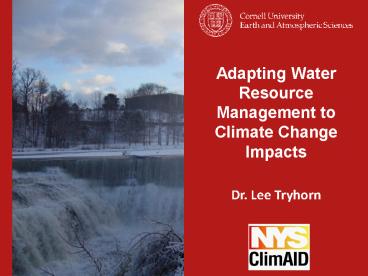Adapting Water Resource Management to Climate Change Impacts - PowerPoint PPT Presentation
1 / 30
Title:
Adapting Water Resource Management to Climate Change Impacts
Description:
Reduced Vulnerability and Enhanced Adaptive Capacity ... Cortland. Delaware. Dutchess. Erie. Essex. Franklin. Fulton. Genesee. Greene. Hamilton. Herkimer ... – PowerPoint PPT presentation
Number of Views:157
Avg rating:3.0/5.0
Title: Adapting Water Resource Management to Climate Change Impacts
1
Adapting Water Resource Management to Climate
Change Impacts
Dr. Lee Tryhorn
2
Talk Outline
- Overview of NYS ClimAID project
- Evidence of a changing climate
- Climate model predictions for NYS
- Key vulnerabilities for NYS
- Adaptations
3
Climate Risk
Economics Equity and Environmental
Justice Science-Policy Linkages
Adaptation
Vulnerability
CLIMATE-PROTECTED NYS Reduced Vulnerability and
Enhanced Adaptive Capacity
4
Water Sector Team
- Rebecca Schneider (co-leader, Cornell)
- Andrew McDonald (co-leader, Cornell)
- Art DeGaetano (climate, Cornell)
- Alan Frei (hydrology modeler, CUNY)
- Susan Riha (Director, NYS WRI)
- Steve Shaw (hydrologist, Cornell)
- Lee Tryhorn (climate, Cornell)
- Contact Lee.Tryhorn_at_cornell.edu
PIs C. Rosensweig (Columbia), A. DeGaetano
(Cornell), W. Solecki (CUNY)
5
Talk Outline
- Overview of NYS ClimAID project
- Evidence of a changing climate
- Climate model predictions for NYS
- Key vulnerabilities for NYS
- Adaptations
6
Precipitation Increases
7
Decreases in snow cover
8
Increase in lake-effect snow
9
Talk Outline
- Overview of NYS ClimAID project
- Evidence of a changing climate
- Climate model predictions for NYS
- Key vulnerabilities for NYS
- Adaptations
10
Future projections
- Increased winter precipitation with more falling
as rain. - Increases in the frequency and intensity of heavy
rainfall events, coupled with the potential for
more summer drought
11
Future projections
Northeast Climate Impact Assessment, 2007
12
Talk Outline
- Overview of NYS ClimAID project
- Evidence of a changing climate
- Climate model predictions for NYS
- Key vulnerabilities for NYS
- Adaptations
13
Vulnerabilities More flooding?
In New York, flood damages were 54.8 million in
2006
14
Vulnerabilities More flooding?
1955 Hurricanes Diane Connie
1984 5 consecutive days of moderate rain
Ten-Mile Creek (Dutchess Ct.)
Identified from 50 yr long USGS discharge record
15
Vulnerabilities
16
Vulnerabilities Design criteria
- Central Park
- 1940 - 1960 1970-2006
- 2-yr 3.10 3.86
- 50-yr 6.21 7.31
- 100-yr 7.22 8.39
- Ithaca
- 2-yr 2.43 2.49
- 50-yr 4.46 5.73
- 100-yr 5.08 6.86
17
Combined Sewer Overflows (CSOs)
- already occur with rainfall gt 1/hr
- 24 billion gallons
- untreated sewage/yr
- enter Great Lakes
- (Sierra Legal rpt
- 12/06)
18
Vulnerabilities Short-term droughts
- Increased frequency of short-terms droughts
- Impacts on crops, livestock, reservoirs, and
municipal well supplies.
2.9 million acres of agricultural land in NY
(NASS, 2006) 3.1 billion value of agricultural
products (NASS, 2006)
Approximately 2.5 of NY agricultural land is
irrigated (NASS, 2002). Drought is already a
significant production constraint in many years.
19
Vulnerabilities Sea-level rise
- Sea level rise with shoreline flooding, salt
water intrusion and groundwater degradation in
New Yorks coastal areas.
Three million people on Long Island are dependent
on groundwater resources
20
Talk Outline
- Overview of NYS ClimAID project
- Evidence of a changing climate
- Climate model predictions for NYS
- Key vulnerabilities for NYS
- Adaptations
21
Dealing with climate change through adaptation
- Proactive management
- Anticipating challenges and building resilience
- GOOD NEWS!
- New York has a wealth of water resources!
22
NYS Water Resources
- 40 inches of average annual precipitation
- 1,236 sq. miles of lakes, ponds, reservoirs
- 577 miles of Great Lakes shoreline
- 52,337 miles of rivers and streams
- 1,530 sq. miles of estuaries, bays, and harbors
- 3,750 sq. miles of freshwater wetlands
- Extensive groundwater resources
23
Multiple Scales of Adaptation
- Local Context specific adaptation strategies
- Regional Leadership
- Statewide government role
- National context for planning and policy
- Temporal scale lt10 yrs, 10-40 yrs, 40yrs
24
Local
- Increase monitoring for water supply
- 2. Engage volunteer groups and private citizens
to multiply agency efforts in monitoring and
management. Give them training and tools. - 3. Water quality
- Disconnect existing CSOs
- Update manure spreading practices
- Require septic system maintenance
- 4. Phased withdrawal from
- high-flood risk, floodplain areas
- Conduct buy-outs after floods
- Move wastewater treatment plants
- Transfer land to public parks
25
Regional strategies
- Lead short, long-term planning tailored to the
region - Prioritize climate change issues and needs
- Planning documents will be key to access funds
for implementation as they become available via
Federal Stimulus/ other. - Identify a centrally-located lead office to share
resources, expertise, demonstration sites with
surrounding region - Organize monitoring networks and data collection
- E.g. water supply, floods, droughts.
- Organize rapid response plan and team
26
State Gov Role
- Mainstream climate change into all planning and
regulations update to reflect most recent
climate data - Funnel state and federal funds to implement
projects - Institutionalize mechanisms for long-term
monitoring and centralized data collection - Provide guidance and technical training
- Identify and alleviate bottlenecks inhibiting
adoption - Develop criteria for prioritization in face of
limiting resources (e.g. vulnerability, ecosystem
value, economics.) - Support targeted research
27
A National context...
28
Greater political and economic pressure for
inter-basin water transfers to water-stressed
regions, both nationally and internationally?
The Great Lakes Basin contains 95 of the fresh
surface waters in North America and 20 of the
freshwater globally.
29
Adaptation planning in a national context
- Pro-active planning of a statewide water program,
including water conservation practices and
pricing controls to manage during droughts, or
export .
30
Questions?































